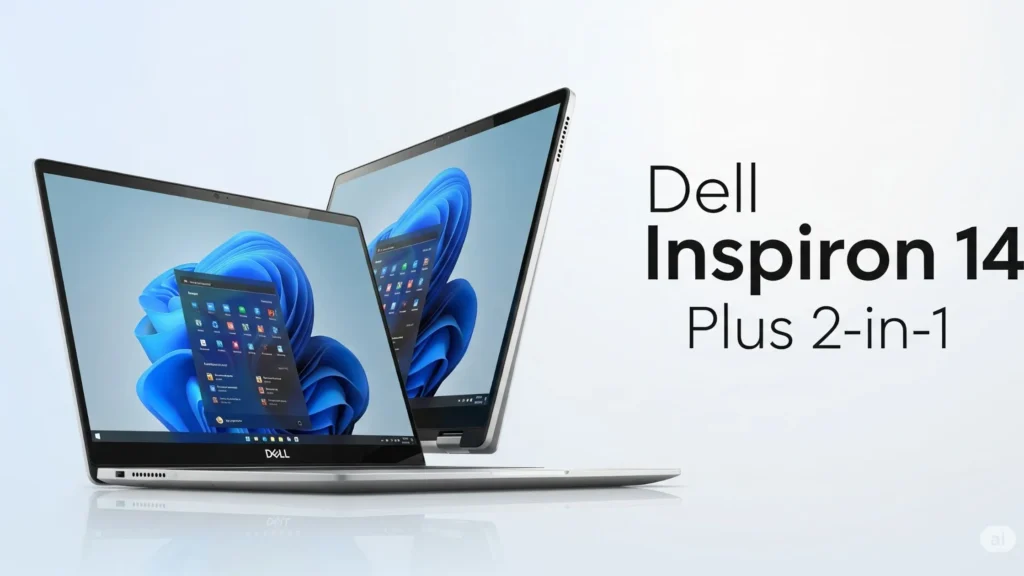Dell Inspiron 14 Plus 2-in-1 Review: AMD Brings a Surprising Edge Over Intel
August 2025 | Laptop Review | Convertible Tech
The Dell Inspiron 14 Plus 2-in-1 (2025) has arrived, and it’s quickly turning heads — not just for its sleek convertible design and high-resolution display, but for what’s powering it. This time, Dell gives buyers the choice between AMD Ryzen 8040 Series processors and Intel Core Ultra chips, and based on early benchmarks and real-world use, AMD may actually have the upper hand.
In a world long dominated by Intel’s mobile CPUs, this shift is more than interesting — it’s strategic. Here’s a detailed look at why the AMD-powered version of Dell’s latest convertible might be your best bet.
🔄 Design & Build: Premium Feel with Modern Flexibility
The Inspiron 14 Plus 2-in-1 remains true to its form factor roots — slim, portable, and built with quality materials. It features a 14-inch 2.8K touch display (2880 x 1800), a sturdy 360-degree hinge, and an aluminum chassis that feels more premium than previous Inspiron models.
The display supports 100% sRGB color, making it great for casual creatives or Netflix bingers alike. The touchscreen is responsive, and pen support (active stylus sold separately) is available for students and digital artists.
Weight comes in at just under 1.6kg, making it manageable for frequent travelers or students on the go.
🧠 Performance: AMD Ryzen 7 8840HS vs Intel Core Ultra 7
Here’s where things get really interesting.
The AMD configuration is powered by the Ryzen 7 8840HS, a Zen 4 architecture chip with 8 cores and 16 threads. It includes Radeon 780M integrated graphics, which outperform Intel’s Arc iGPUs in most real-world tests. Compared to the Intel Core Ultra 7 155H, AMD offers better multithreaded performance, lower power draw, and cooler thermal behavior — all key advantages for a thin-and-light 2-in-1.
Benchmarks (average across reviews):
- Geekbench 6 (multi-core): AMD – 12,800 | Intel – 11,900
- Cinebench R23 (multi-core): AMD – 14,200 | Intel – 13,100
- Battery life (mixed use): AMD – ~11.5 hrs | Intel – ~9.5 hrs
These numbers show AMD pulling ahead, especially for users who multitask heavily or work in creative software like Adobe Photoshop or DaVinci Resolve.
🎮 Graphics: Radeon 780M > Intel Arc
The Radeon 780M integrated GPU delivers surprisingly good performance for light gaming and creative work. Titles like Fortnite, Valorant, and even Cyberpunk 2077 (low-medium settings) are playable at 1080p — something Intel’s Arc graphics struggle to match consistently.
For students or casual creators who want a do-it-all machine without a discrete GPU, AMD is the clear winner here.
🔋 Battery Life: AMD’s Efficiency Shines
Thanks to its efficient 4nm fabrication process, AMD Ryzen 8040 chips draw less power than Intel’s hybrid-core architecture. In practical use, the AMD model consistently offers 2-3 more hours of battery life under the same workloads, including web browsing, video calls, and office productivity.
🎧 Audio, Keyboard & Ports
The dual speakers offer decent sound for a midrange device, with Dolby Atmos support improving clarity and immersion.
The keyboard is backlit, tactile, and comfortable for long typing sessions. The glass precision trackpad is responsive, though slightly smaller than some competitors.
Port selection is solid:
- 2 x USB-C (1 with DisplayPort + Power Delivery)
- 1 x USB-A 3.2
- 1 x HDMI 1.4
- MicroSD card reader
- 3.5mm combo audio jack
🛒 Price & Verdict
Pricing starts at:
- ₹92,999 (~$1,099) for the AMD Ryzen 7 variant
- ₹99,999 (~$1,179) for the Intel Core Ultra 7 configuration
Verdict: If you’re considering the Dell Inspiron 14 Plus 2-in-1, the AMD model is the better value. It delivers stronger performance, better battery life, and cooler operation — all in a versatile, premium-feeling package.
Unless you absolutely need Intel’s AI-accelerated NPU (for niche workflows), AMD is the smarter buy in 2025.



